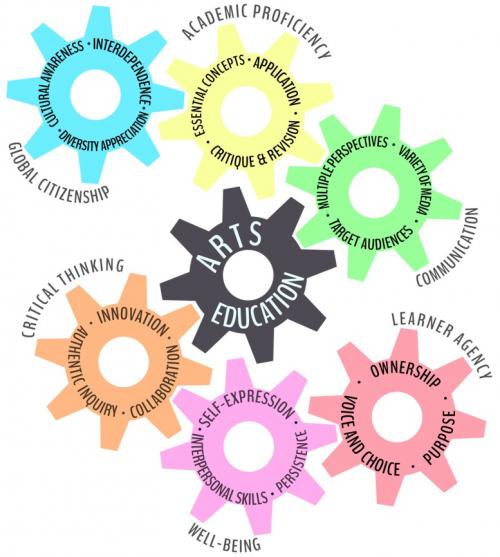The visual and performing arts provide avenues for students to investigate and develop a positive sense of self, place, and purpose. Approved for adoption by the Vermont State Board of Education in 2016, the National Core Arts Standards (NCAS) address essential questions and skills to support students in this investigation through five arts disciplines: Dance, Music, Theater, Visual Arts, and Media Arts. NCAS outline critical components of the creative process under the umbrella of four domains (Create, Perform/Present/Product, Respond, and Connect) to guide students through rigorous exploration of skills in artistic literacy. These standards (and arts education in general) emphasize transferable skills through growth-oriented and participant-driven creative outlets to prepare students for college, career, and life.
Implementing High School Priority Performance Indicators in the Arts
Implementing High School Priority Performance Indicators in the Arts illustrates suggestions for the practical implementation of the Arts Proficiency-Based Graduation Hierarchy within specific content areas. It is not designed to prescribe specific content or instructional methods to educators but rather to provide insights into how the hierarchy can be realized in practice.
Road Maps to Proficiency in the Arts
The primary objective of the Arts PBGR Hierarchy is to integrate all content areas cohesively. Given that the Arts PBGR Hierarchy represents all arts disciplines, these road map documents were crafted to illustrate the vertical alignment of Priority Performance Indicators in each of the arts disciplines and to emphasize the utilization of Prioritized Grade Level Standards in their creation.
Spotlights on Equity Resources
Educational equity means that every student has access to the resources, opportunities, and educational rigor they need at the right moment in their education, whatever their race, gender/identity, sexual orientation, ethnicity, religion, language, ability, family background, or family income may be. (Adapted from CCSSO, Leading for Equity.) The Spotlight on Equity Resource below provides a list of considerations and resources for the purpose of supporting equity and access while emphasizing high-quality and culturally sustaining learning opportunities for all students.
Section List
Arts Education: A Path to a Portrait of a Graduate
Vermont Arts Instructional Recommendations
Arts Education: A Path to a Portrait of a Graduate
The visual and performing arts can serve as a pedagogical tool for supporting the performance indicators in the Vermont Portrait of a Graduate. Embedded in the Portrait are key concepts explorable through the arts. Whether districts have developed their own Portraits or are using the Vermont Portrait as a framework, arts education can be a source of guidance for intentionally and meaningfully focusing on the attributes in school settings. Information on how NCAS-aligned arts curricula can guide a Portrait of a Graduate can be found here:
The Vermont Framework for Proficiency: Artistic Literacy description serves as a foundation on which to build The Arts Proficiency-Based Graduation Requirements, Critical Proficiencies, and Priority Performance Indicators.

The arts support global citizenship by fostering interdependence, diversity appreciation, and cultural awareness. They support academic proficiency by teaching skills on essential concepts, application, and revision. They support communication by focusing on students' perspectives, non-verbal strategies, and a variety of media. The arts support critical thinking through collaboration, authentic inquiry, and innovation. They support well-being through self-expression, persistence, and interpersonal skills. Lastly, they support learner agency by offering voice and choice, ownership, and high expectations.
Vermont Arts Instructional Recommendations
Arts programs support students in developing and sustaining skills in artistic literacy while demonstrating proficiency in the National Core Arts Standards. Considerations and recommendations for providing these opportunities are described in the Visual and Performing Arts Instructional Recommendations and Resource Compendium document. The purpose of this document is to support Vermont programs in providing a holistic learning experience to students while upholding the Education Quality Standards as they pertain to the arts. In addition to embedding attributes of a Vermont Portrait of a Graduate into arts curricula, these considerations can serve to support preservation of the arts in schools and the essential skills and qualities obtained from arts education:
Newsletters
- Winter 2025
- Summer 2024
- Spring 2024
- September 2023
- January 2022
- September 2021
- April 2021
- February 2021
- November 2020
Resources
Learning Target Bank
The Vermont Arts Learning Target Bank is a collection of learning targets aligned to the National Core Arts Standards. The targets are available for all five NCAS arts disciplines: Dance, Music, Media Arts, Theater, and Visual Art. The NCAS performance standards for Kindergarten to Advanced High School have been “unpacked” into learning targets. Educators can use them to communicate targets with students or apply them to measurable criteria in a specific domain or medium.
The learning targets were created and vetted by Vermont educators to help implement the National Core Arts Standards. They are available to all Vermont educators as they continue to implement personalized, proficiency-based classroom systems.
- Introduction to the Vermont Arts Learning Target Bank
- How to Use the Vermont Arts Learning Target Bank
Dance
Media Arts
Music
- Kindergarten Learning Targets
- 2nd Grade Learning Targets
- 5th Grade Learning Targets
- 8th Grade Learning Targets
- High School Proficient Learning Targets
Theater
Visual Art
- Kindergarten Learning Targets
- 1st Grade Learning Targets
- 2nd Grade Learning Targets
- 3rd Grade Learning Targets
- 4th Grade Learning Targets
- 5th Grade Learning Targets
- 6th Grade Learning Targets
- 7th Grade Learning Targets
- 8th Grade Learning Targets
- High School Proficient Learning Targets
- High School Accomplished Learning Targets
Title IV, Part A and the Arts Resources
- ESSA and the Arts Introduction
- Level of Evidence and the Arts
- ESSA and the Arts: Title IV, Part A and FAQ
-
Impact and Outcomes of Title IV-A: Advancing children’s success through access to a well-rounded education
The NAMM Foundation, together with the National Association for Music Education (NAfME), collected evidence in early 2019 about school district use of Title IV-A funds, or the Student Support and Academic Enrichment Grants (SSAEG) in ESSA.
Questions?
Email Eric Howard
